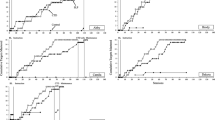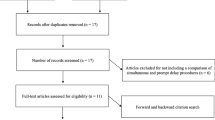Abstract
This investigation compared the effectiveness and efficiency of constant time delay (CTD) and simultaneous prompting (SP) procedures in teaching discrete social studies facts to 4 high school students with learning and behavior disorders using an adapted alternating treatments design nested within a multiple probe design. The results indicated that both procedures were effective, with the simultaneous prompting procedure being slightly more efficient in terms of errors during instructional and maintenance phases. In addition, when interviewed about their preferences, both the instructor and participants preferred the simultaneous prompting procedure. This investigation extends current research as there are small numbers of studies comparing SP to other response prompting strategies, and to date, SP and CTD have not been compared with high school students with high-incidence disabilities. Future research issues are discussed.




Similar content being viewed by others
References
Batu, S. (2008). Caregiver-delivered home-based instruction using simultaneous prompting for teaching home skills to individuals with developmental disabilities. Education and Training in Developmental Disabilities, 43, 541–555.
Billingsley, F. F., White, O. R., & Munson, R. (1980). Procedural reliability: A rationale and an example. Behavioral Assessment, 2, 229–241.
Birnbauer, J. S. (1981). External validity and experimental investigation of individual behavior. Analysis and Intervention in Developmental Disabilities, 1, 117–132.
Browder, D., Ahlgrim-Delzell, L., Spooner, F., Mims, P. J., & Baker, J. N. (2009). Using time delay to teach literacy to students with severe developmental disabilities. Exceptional Children, 75, 343–364.
Browder, D. M., & Minarovic, T. J. (2000). Utilizing sight words in self-instruction training for employees with moderate mental retardation in competitive jobs. Education and Training in Developmental Disabilities, 35, 78–89.
Campbell, M. L., & Mechling, L. C. (2009). Small group computer-assisted instruction with SMART board technology: An investigation of observational and incidental learning of nontarget information. Remedial and Special Education, 30, 47–57.
Cloninger, C. J. (2004). Designing collaborative educational services. In F. P. Orelove, D. Sobsey, & R. K. Silberman (Eds.), Educating children with multiple disabilities: A collaborative approach (4th ed., pp. 1–29). Baltimore: Brookes.
Cohen, E. T., Heller, K. W., Alberto, P., & Fredrick, L. D. (2008). Using a three-step decoding strategy with constant time delay to teach word reading to students with mild and moderate mental retardation. Focus on Autism and Other Developmental Disabilities, 23, 67–78.
Collins, B. C., Gast, D. L., Wolery, M., Holcombe, A., & Leatherby, J. G. (1991). Using constant time delay to teach self-feeding to young students with severe/profound handicaps: Evidence of limited effectiveness. Journal of Developmental and Physical Disabilities, 3, 157–179.
Collins, B. C., Schuster, J. W., & Nelson, C. M. (1992). Teaching a generalized response to the lures of strangers to adults with severe handicaps. Exceptionality, 3, 67–80.
Colozzi, G. A., Ward, L. W., & Crotty, K. E. (2008). Comparison of simultaneous prompting procedure in 1:1 and small group instruction to teach play skills to preschool students with pervasive developmental disorder and developmental disabilities. Education and Training in Developmental Disabilities, 43, 226–248.
Dogan, O. S., & Tekin-Iftar, E. (2002). The effects of simultaneous prompting on teaching receptively identifying occupations from picture cards. Research in Developmental Disabilities, 23, 237–252.
Etzel, B. C., & LeBlanc, J. M. (1979). The simplest treatment alternative: Appropriate instructional control and errorless learning procedures for the difficult-to-teach child. Journal of Autism and Developmental Disorders, 9, 361–382.
Fickel, K. M., Schuster, J. W., & Collins, B. C. (1998). Teaching different tasks using different stimuli in a heterogeneous small group. Journal of Behavioral Education, 8, 219–244.
Gast, D. L. (2010). Single subject research methodology in behavioral sciences. New York: Routledge.
Gast, D. L., Winterling, V., Wolery, M., & Farmer, J. A. (1992). Teaching first-aid skills to students with moderate handicaps in small group instruction. Education and Treatment of Children, 15, 101–124.
Gibson, A. N., & Schuster, J. W. (1992). The use of simultaneous prompting for teaching expressive word recognition to preschool children. Topics in Early Childhood Special Education, 12, 247–267.
Horner, R. H., Carr, E. G., Halle, J., McGee, G., Odom, S., & Wolery, M. (2005). The use of single-subject research to identify evidence-based practice in special education. Exceptional Children, 71, 165–180.
Jameson, J. M., McDonnell, J., Polychronis, S., & Riesen, T. (2008). Embedded, constant time delay instruction by peers without disabilities in general education classrooms. Intellectual and Developmental Disabilities, 46, 346–363.
Johnson, P., Schuster, J. W., & Bell, J. K. (1996). Comparison of simultaneous prompting with and without error correction in teaching science vocabulary words to high school students with mild disabilities. Journal of Behavioral Education, 6, 437–458.
Keel, M., & Gast, D. L. (1992). Small group instruction for students with learning disabilities: A study of observational and incidental learning. Exceptional Children, 58, 357–368.
Kurt, O., & Tekin-Iftar, E. (2008). A comparison of constant time delay and simultaneous prompting within embedded instruction on teaching leisure skills to children with autism. Topics in Early Childhood Special Education, 28, 53–64.
Maciag, K. G., Schuster, J. W., Collins, B. C., & Cooper, J. T. (2000). Training adults with moderate and severe mental retardation in a vocational skill using a simultaneous prompting procedures. Education and Training in Mental Retardation and Developmental Disabilities, 35, 306–316.
Morse, T. E., & Schuster, J. W. (2004). Simultaneous prompting: A review of the literature. Education and Training in Developmental Disabilities, 39, 153–168.
Parker, M. A., & Schuster, J. W. (2002). Effectiveness of simultaneous prompting on the acquisition of observational and instructive feedback stimuli when teaching a heterogeneous group of high school students. Education and Training in Mental Retardation and Developmental Disabilities, 37, 89–104.
Parrott, K. A., Schuster, J. W., Collins, B. C., & Gassaway, L. J. (2000). Simultaneous prompting and instructive feedback when teaching chained tasks. Journal of Behavioral Education, 10, 3–19.
Rao, S., & Mallow, L. (2009). Using simultaneous prompting procedure to promote recall of multiplication facts by middle school students with cognitive impairment. Education and Training in Developmental Disabilities, 44, 80–90.
Riesen, T., McDonnell, J., Johnson, J. W., Polychronis, S., & Jameson, M. (2003). A comparison of constant time delay and simultaneous prompting within embedded instruction in general education classes with students with moderate to severe disabilities. Journal of Behavioral Education, 12, 241–259.
Schuster, J. W., Griffen, A. K., & Wolery, M. (1992). Comparison of simultaneous prompting and constant time delay procedures in teaching sight words to elementary students with moderate mental retardation. Journal of Behavioral Education, 2, 305–325.
Schuster, J. W., Morse, T. E., Ault, M. J., Doyle, P. M., Crawford, M. R., & Wolery, M. (1998). Constant time delay with chained tasks: A review of the literature. Education and Treatment of Children, 21, 74–106.
Schuster, J. W., Stevens, K. B., & Doak, P. K. (1990). The use of constant time delay to teach word definitions to students with mild handicaps. Journal of Special Education, 24, 306–318.
Sindelar, P. T., Rosenberg, M. S., & Wilson, R. J. (1985). An adapted alternating treatments design for instructional research. Education and Treatment in Children, 8, 67–76.
Stevens, K. B., Blackhurst, A. E., & Slaton, D. B. (1991). Teaching memorized spellings with a microcomputer: Time delay and computer assisted instruction. Journal of Applied Behavior Analysis, 24, 53–160.
Tekin, E., & Kircaali-Iftar, G. (2002). Comparison of the effectiveness and efficiency of two response prompting procedures delivered by sibling tutors. Education and Training in Mental Retardation and Developmental Disabilities, 37, 283–299.
Tekin-Iftar, E. (2008). Parent-delivered community-based instruction with simultaneous prompting for teaching community skills to children with developmental disabilities. Education and Training in Developmental Disabilities, 43, 249–265.
Touchette, P. (1971). Transfer of stimulus control: Measuring the moment of transfer. Journal of Experimental Analysis of Behavior, 15, 347–354.
U.S. Department of Education (2004a). Public law print of PL 107-110 the No Child Left Behind Act of 2001. Retrieved March 20, 2009, from http://www.ed.gov/policy/elsec/leg/esea02/index.html.
U.S. Department of Education (2004b). Overview: Four pillars of NCLB. Retrieved March 10, 2009, from http://www.ed.gov/nclb/overview/intro/4pillars.html.
Wechsler, D. (1991).Wechsler intelligence scale for children (3rd ed.). Columbus, OH: Harcourt, Brace, Jovanovich.
Wechsler, D. (1997). Wechsler intelligence scale for children—Revised. Columbus, OH: Harcourt, Brace, Jovanovich.
Wolery, M., Ault, M. J., & Doyle, P. M. (1992a). Teaching students with moderate to severe disabilities: Use of response prompting strategies. New York: Longman.
Wolery, M., Bailey, D. B., Jr., & Sugai, G. M. (1988). Effective teaching: Principles and procedures of applied behavior analysis with exceptional students. Boston: Allyn and Bacon.
Wolery, M., Holcombe, A., Cybriwsky, C., Doyle, P. M., Schuster, J. W., Ault, M. J., et al. (1992b). Constant time delay with discrete responses: A review of effectiveness and demographic, procedural, and methodological parameters. Research in Developmental Disabilities, 13, 239–266.
Wolf, M. M. (1978). Social validity: The case for subjective measurement or how applied behavior analysis is finding its heart. Journal of Applied Behavior Analysis, 11, 203–214.
Acknowledgments
The authors wish to thank Jean Hess for her assistance with the manuscript.
Author information
Authors and Affiliations
Corresponding author
Additional information
This study was conducted to partially satisfy the thesis requirements for a Master of Science degree in Education in the Department of Special Education and Rehabilitation Counseling, University of Kentucky.
Rights and permissions
About this article
Cite this article
Head, K.D., Collins, B.C., Schuster, J.W. et al. A Comparison of Simultaneous Prompting and Constant Time Delay Procedures in Teaching State Capitals. J Behav Educ 20, 182–202 (2011). https://doi.org/10.1007/s10864-011-9127-8
Published:
Issue Date:
DOI: https://doi.org/10.1007/s10864-011-9127-8




